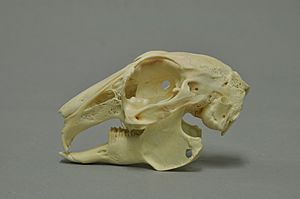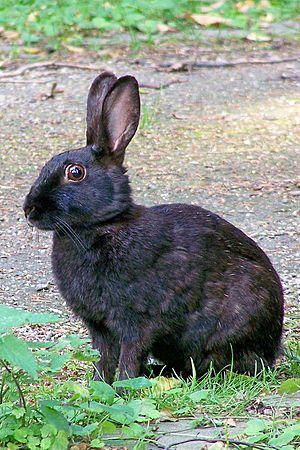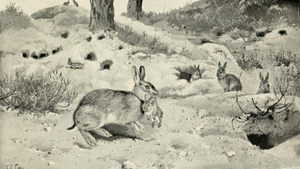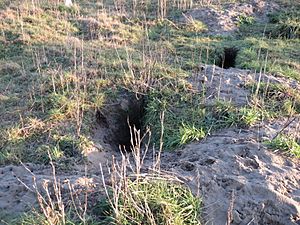European rabbit facts for kids
Quick facts for kids European rabbit |
|
|---|---|
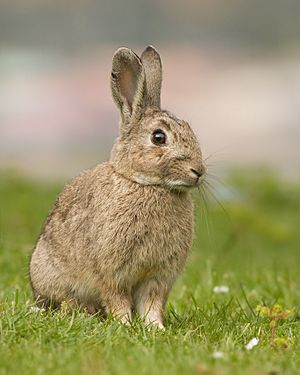 |
|
| Conservation status | |
| Scientific classification | |
| Genus: |
Oryctolagus
|
| Species: |
cuniculus
|
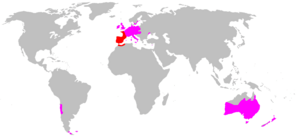 |
|
| Range map: Native Introduced | |
| Synonyms | |
|
Lepus cuniculus Linnaeus, 1758 |
|
The European rabbit (Oryctolagus cuniculus), also called the cony, is a type of rabbit that originally comes from the Iberian Peninsula. This area includes Spain, Portugal, and southwestern France. These rabbits have been moved to many other places around the world. Sometimes, this has caused big problems for the local plants and animals.
In their native home, the number of European rabbits has gone down. This is due to diseases like myxomatosis and rabbit calicivirus, too much hunting, and losing their homes. This decline has also affected animals that rely on them for food, such as the Iberian lynx and the Spanish imperial eagle. European rabbits are known as an invasive species because they have been introduced to almost every continent except Antarctica. They have caused many environmental issues. For example, in Australia, they have had a huge impact because there are not many natural predators there.
European rabbits are famous for digging large networks of tunnels called warrens. They spend most of their time in these tunnels when they are not looking for food. Unlike hares, baby rabbits are born blind and without fur. They are born in a fur-lined nest inside the warren and need their mother for everything. Much of what we know about wild rabbit behavior comes from research done in the 1960s. Ronald Lockley, a naturalist, studied rabbit colonies and wrote a popular book called The Private Life of the Rabbit. This book helped Richard Adams write his famous novel Watership Down.
Contents
Rabbit Names and Their History
The words "cony" and "rabbit" are not originally English words. They came from other languages. "Cony" was used first, starting in the 1200s, to talk about the rabbit's fur. Later, "cony" meant an adult rabbit, while "rabbit" was used for the young ones.
The word "cony" comes from the Old French word connil. The Latin word for rabbit, cuniculus, also comes from this root. The word "rabbit" comes from the Walloon word rabett.
The home of rabbits is called a warren. This word comes from an Old English word that meant a protected area.
Rabbit Family Tree
The European rabbit was once thought to be in the same group as hares. But in 1874, it was given its own group, or genus, called Oryctolagus. This was because baby rabbits are born helpless, they dig burrows, and their bones are different.
European rabbits look a bit like the cottontail rabbits from North America. Both are born blind and naked, and they don't show much difference between males and females. However, their skulls are different. Also, cottontails don't usually dig their own burrows like European rabbits do. Scientists have found that their similar looks are due to convergent evolution. This means they developed similar traits because they live in similar ways, not because they are closely related. The closest relatives of the European rabbit are the hispid hare, the riverine rabbit, and the Amami rabbit.
Rabbit Types
Scientists recognize different types, or subspecies, of the European rabbit. As of 2005, there were six known subspecies. However, newer studies from 2008 suggest there are mainly two types: O. c. algirus and O. c. cuniculus. These two types mix in central Iberia.
| Subspecies | Where it lives | What it looks like |
|---|---|---|
| Common rabbit O. c. cuniculus |
Native to most of Europe, except very cold or high-up areas. Introduced to Australia, New Zealand, Chile, Africa, and some islands. |
|
| Iberian rabbit O. c. algirus |
Native to Portugal, southern Spain, North Africa, and islands in the Mediterranean Sea and Atlantic Ocean. | |
| Mediterranean rabbit O. c. huxleyi |
Introduced to warm Atlantic islands like Madeira and the Azores. | Can be very large or very small. Rabbits on Madeira are lighter and more reddish. |
| Cretan rabbit O. c. cnossius |
Native to Crete. | A small subspecies. |
| Camargue rabbit O. c. brachyotus |
Native to salt marshes in Camargue, southern France. | A black, small-headed subspecies with short ears. |
| Domestic rabbit O. c. domesticus |
Domesticated (kept as pets or for food). | |
| African rabbit O. c. habetensis |
Native to Morocco and areas near the Strait of Gibraltar. |
What European Rabbits Look Like
The European rabbit is smaller than the European hare and mountain hare. It does not have black ear-tips and its legs are shorter. An adult European rabbit can be about 40 centimeters (16 inches) long. It usually weighs between 1.2 and 2 kilograms (2.6 to 4.4 pounds). Its hind feet are about 8.5 to 10 centimeters (3.3 to 3.9 inches) long, and its ears are about 6.5 to 7.5 centimeters (2.6 to 3 inches) long.
Their size and weight can change depending on the food and habitat. Rabbits living in areas with rich farmland and plenty of food are usually bigger. It is rare to find a pure European rabbit weighing more than 5 kilograms (11 pounds). Unlike brown hares, male European rabbits are usually heavier than females.
The fur of a European rabbit is typically grayish-brown, but the color can vary a lot. The longer guard hairs have bands of brown and black or grey. The back of their neck is reddish. Their chest is brown, and the rest of their belly is white or grey. Young rabbits often have a white star on their forehead, but this is rare in adults. Their whiskers are long and black, and their feet are fully covered in buff-colored fur. The underside of their tail is white. This white tail becomes very noticeable when they run away from danger. It might be a signal to other rabbits to escape.
Rabbits shed their fur once a year. This starts in March on their face and spreads to their back. Their soft underfur is completely replaced by October or November. European rabbits can have many different colors, from light sandy to dark grey or even completely black. Black rabbits are not uncommon in Europe, but white (albino) ones are rare.
Life and Behavior of Rabbits
Social Life and Territory
European rabbits live in warrens with 2 to 10 other rabbits. These groups help them to breed more successfully. Being territorial and aggressive helps rabbits grow up and survive. Female rabbits are usually more territorial than males. They mark their areas with piles of dung.
The size of a rabbit's home area depends on its habitat, food, shelter, and places to breed. It is usually small, about 0.3 to 0.7 hectares (0.7 to 1.7 acres). Male rabbits often have larger areas than females, unless there are few rabbits and lots of good food. European rabbits usually stay close to their burrows. When they eat in fields, they typically stay within 25 meters (82 feet) of their burrow, and rarely go further than 50 meters (164 feet). However, they might move up to 500 meters (1,640 feet) if their environment suddenly changes, like after a harvest. This behavior might help them avoid predators.
European rabbits are social animals. They live in stable groups where females share access to one or more burrow systems. However, in places where it's easy to dig burrows, their social groups might be less strict. Both male and female rabbits have a pecking order, or dominance hierarchy. Among males, their status depends on how much access they have to females. Dominant males father most of the babies in the colony. Dominant females get the best nesting spots. Competition for these spots can lead to serious injuries or even death. Lower-status females, especially in big colonies, often have to use breeding spots with only one entrance, far from the main warren. This makes them more vulnerable to predators like foxes or badgers.
Reproduction and Life Cycle
In European rabbit groups, dominant males often mate with several females (this is called polygyny). Lower-status males and females often form pairs and mate with only one partner (this is called monogamy). Rabbits show they are ready to mate by rubbing a special gland under their chin on other animals or objects. This is called "chinning."
Male European rabbits can sometimes be friendly with each other. But during the breeding season, which is usually from January to August, fierce fights can break out among them. Females have several litters of babies (usually 3-7 kittens) each year. If there are too many rabbits, pregnant females might lose all their embryos. Just before giving birth, the female rabbit digs a separate burrow called a "stop" or "stab." These breeding burrows are usually a few feet long and are lined with grass, moss, and fur from the mother's belly. This special burrow protects the baby rabbits from adult males and predators.
The pregnancy of a European rabbit lasts 30 days. About half the babies born are male and half are female. Babies born to the dominant male and female tend to grow bigger and stronger. This is because their parents have better nesting and feeding areas. It's common for European rabbits to mate again right after giving birth. Some have even been seen nursing their older young while pregnant with new ones.
Female European rabbits nurse their babies once a night, for only a few minutes. After feeding, the mother seals the entrance to the burrow with soil and plants. In their native areas, baby European rabbits grow about 5 grams (0.18 ounces) per day. In other places, they might grow 10 grams (0.35 ounces) per day. They weigh about 30-35 grams (1.1-1.2 ounces) at birth. By 21-25 days, when they are being weaned, they weigh 150-200 grams (5.3-7.1 ounces).
Baby European rabbits are born blind, deaf, and almost naked. Their ears can start moving at 10 days old and stand up at 13 days. Their eyes open 11 days after birth. At 18 days old, the babies start leaving the burrow. Males can start breeding at four months old, while females can start at three to five months.
Digging Behavior
European rabbits usually dig their burrows on slopes and banks, where water drains away easily. The entrances to their burrows are typically 10–50 centimeters (4–20 inches) wide. You can easily spot them by the bare earth around their openings. The constant movement of rabbits prevents plants from growing there.
Large burrows are complex tunnels that can go several feet deep. Rabbits dig by pulling soil backward with their front paws and throwing it between their back legs, which then scatter the dirt. Most burrows are dug from the outside. However, some warrens have holes dug from the inside. These act as emergency exits when rabbits need to escape from predators underground. These holes usually go straight down for 3–4 feet (0.9–1.2 meters). They don't have the bare earth around them like main entrances.
Baby rabbits sleep in chambers lined with grass and fur. Adult rabbits sleep on the bare earth, likely to avoid dampness. They keep warm by huddling together. Both male and female rabbits dig, but females are better at it and dig for longer periods.
Communication
The European rabbit is usually a quiet animal, but it does make at least two sounds. The most well-known sound is a high-pitched scream or squeal. This is a distress call, like the cry of a piglet. They make this sound when they are in extreme danger, such as when caught by a predator or a trap.
In the spring, male rabbits make grunting sounds when they approach other rabbits. These grunts are like shrill hiccups and are made with their mouth closed. They show they are happy or content with these sounds. When they are aggressive, they make a low growl.
Rabbit Ecology
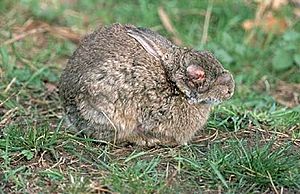
Rabbit Habitat
The perfect home for a European rabbit is short grasslands with safe places to hide. These hiding spots can be burrows, large rocks, hedgerows, bushes, or woodlands. These safe places should be close to where they eat. They can live up to the treeline, as long as the ground drains well and there is shelter.
The size and layout of their burrow systems depend on the type of soil. In areas with loose soil, they choose spots with strong support, like tree roots or shrubs, to prevent their burrows from collapsing. Warrens tend to be larger and have more connected tunnels in areas with chalk than in sandy areas. In large pine forests, rabbits only live on the edges and along paths.
What Rabbits Eat
European rabbits eat many different types of plants, especially grasses. They prefer the young, juicy leaves and shoots of the most nutritious plants, like fescues. In mixed farm areas, they like winter wheat more than maize (corn) or other broad-leaf plants.
During summer, European rabbits eat the shortest, and therefore less nutritious, grass. This suggests they choose grazing areas based on avoiding predators rather than getting the most food. When food is scarce, they eat more and choose parts of plants with the most nitrogen. Hungry rabbits in winter might even eat tree bark. They also eat blackberries. Rabbits raised in captivity have been fed fodder made of furze (gorse) and acorns, which can help them gain a lot of weight.
The European rabbit is less picky about food than the brown hare. When eating root vegetables, the rabbit eats them whole, while the hare often leaves the peel. Depending on their body's fat and protein, rabbits can survive without food in winter for about 2–8 days. Although they are herbivores (plant-eaters), there have been cases of rabbits eating snails.
Rabbit Predators
Many different animals hunt European rabbits. Foxes, dingoes, wolves, lynxes, wolverines, and dogs hunt both adult and young rabbits. They do this by sneaking up on them in the open. However, not many rabbits are caught this way because they can quickly run back to cover. Also, a study in Spain showed that rabbits might avoid areas where they smell the poop of predators that have recently eaten rabbits.
Both foxes and badgers will dig baby rabbits out of shallow burrows. Badgers are too slow to catch adult rabbits. Both wild and domestic cats will stalk and pounce on rabbits, especially young ones leaving their burrows for the first time. Wildcats eat rabbits depending on how many are available. In eastern Scotland, where rabbits are common, they can make up over 90% of a wildcat's diet. Most domestic cats cannot kill healthy, full-grown adult rabbits, but they will catch weak or sick ones.
Female rabbits can be very protective of their babies. They have been seen chasing away large cats and mustelids, which include ferrets, stoats, and weasels. However, rabbits usually run from mustelids and may naturally fear them. There are stories of rabbits becoming paralyzed with fear and dying when chased by stoats or weasels, even if they were rescued unharmed. European rabbits make up 85% of the polecat's diet. Their availability is important for female mink to successfully raise their young. Brown rats can be a serious danger to baby rabbits. They will live in rabbit burrows during the summer and attack the young in groups.
Many birds of prey can kill rabbits, but few are strong enough to carry them away. Large birds like golden and sea eagles might carry rabbits back to their nests. Smaller eagles, buzzards, and harriers struggle to do so. Hawks and owls usually only carry off very small baby rabbits.
Diseases and Parasites
The European rabbit is the only species that can die from myxomatosis. The most dangerous type of this disease takes five days to show symptoms. After that, the eyelids swell, and the swelling quickly spreads to the ears, forehead, and nose. In the final stages, the swollen areas release a fluid with a lot of the virus. Death usually happens 11-12 days after infection. In Britain, the main carrier of myxomatosis is the flea Spilopsyllus cuniculi. In Australia, it is mosquitoes.
Rabbit haemorrhagic disease (RHD), also called viral haemorrhagic disease (VHD), is a disease specific to the European rabbit. It causes severe liver damage, blood clotting problems, and bleeding, mainly in the lungs. Rabbits that are vulnerable can die within 30 hours of getting infected. Most rabbits in the UK are immune to RHD because they have been exposed to a weaker version of the disease.
Rabbits and Humans
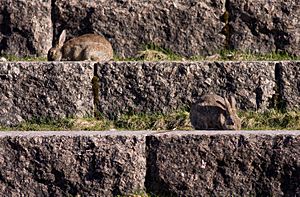
Recent studies show that all European rabbits share common genetic traits. They come from two main family lines. These lines started between 12,000 and 6.5 million years ago when glaciers separated two groups of rabbits. One group was in the Iberian Peninsula, and the other was in Southern France. It is thought that humans started hunting rabbits for food, but more research is needed to confirm this. We don't have much clear information about humans and European rabbits until the Middle Ages.
The first time humans mentioned their relationship with European rabbits was by the Phoenicians before 1000 BC. They called the Iberian Peninsula i-Shaphan-ím, which means "the land of the hyraxes". The Phoenicians called the local rabbits 'hyraxes' because rabbits look a bit like hyraxes, and hyraxes were native to Phoenicia. Hyraxes, like rabbits, are not rodents. One idea is that the Romans changed i-Shaphan-ím to its Latin form, Hispania, which later became "Spain" in English and other languages.
Like the Phoenicians, the ancient Greeks and Romans did not have a specific name for the rabbit. This is because the species was not native to Greece and Italy at that time. They often called it "small hare" or "small digging hare," to tell it apart from the larger European hare that does not dig burrows. The Roman poet Catullus used the name cuniculus (which is where the English word "cony" comes from). He mentioned how many rabbits there were in Celtiberia by calling the region cuniculosa, meaning "rabbit-ridden."
The European rabbit is the only rabbit species that has been domesticated. All 305 different rabbit breeds around the world, from the tiny Netherland Dwarf to the huge Flemish Giant, are descendants of the European rabbit. Rabbits are an example of an animal that can be seen as food, a pet, or a pest by different people in the same culture. In some cities, wild European rabbits (which are descendants of escaped pets) have become a problem. For example, Helsinki, Finland, had about 2,500 European rabbits in 2006, and this number doubled to 5,000 by autumn 2007. In Iceland, European rabbits are found in the city of Reykjavík and on the Vestmannaeyjar islands. In Finland, the introduced European rabbit competes with the native European hare and mountain hare.
Rabbits as an Introduced Species

The European rabbit has been introduced to many new places. Often, this has caused harm to plants and local wildlife, making it an invasive species. The first known mention of the rabbit as an invasive species was when it was brought to the Balearic Islands after the Roman conquest in the 1st century BCE. According to ancient writers, the growing number of rabbits caused famines by destroying crops. They even made trees and houses collapse with their digging. The people asked the Roman emperor Augustus for help. He sent troops to control the rabbit population with the help of ferrets.
European rabbits were also introduced to Great Britain (by the Romans around AD 43), the Hawaiian Islands (Laysan Island in 1903 and Lisianski Island), Macquarie Island in Oceania, Smith Island and San Juan Island in Washington state (around 1900), and several islands off the coast of South Africa (like Robben Island). They were also brought to Australia and New Zealand. There are different stories about how rabbits came to Ukraine. One says they were brought by an Austrian nobleman in the early 1900s. Another says they were brought to Kherson from Switzerland in 1894-1895.
Rabbits in the British Isles
The European rabbit is common in Great Britain, Ireland, and most islands, except for a few small ones. It was probably first brought to Britain by the Normans after their conquest of England in 1066. There are no mentions of rabbits in Britain before the Normans arrived. However, rabbits were still rare in most of England for a while after that. Warrens are not mentioned in the Domesday Book or other documents from the 11th century.
Rabbits became well-known in Britain between the 12th and 13th centuries. The first real proof of their presence is bones found at Rayleigh Castle, which was used from the 11th to 13th centuries. The first mentions of rabbits in Ireland happened around the same time as in England, suggesting another Norman introduction. By the 13th century, they had become very common in some areas. For example, a survey of Lundy Island in 1274 said that 2,000 rabbits were caught there every year. Later, rabbits became an important food source for feasts.
The number of truly wild rabbits slowly increased, mainly in coastal areas and lowland heaths. Big population increases happened after 1750. Changes in farming created good habitats for rabbits, and people became more interested in managing game animals, which led to intense efforts to control predators. Although now common in the Scottish lowlands, the species was not well known in Scotland before the 1800s.
Myxomatosis entered Britain from France in 1953 and reached Ireland by 1954. This led the RSPB to create "Mercy Squads" to humanely kill rabbits suffering from the disease. Major myxomatosis outbreaks still happen in Britain, with peaks in spring and late summer or autumn. However, rabbits have developed some immunity, which has reduced the death rate from 99% to 5-33%.
Rabbits in Australia
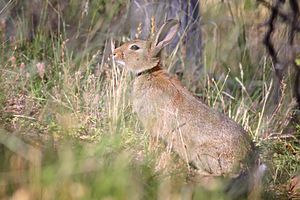
Twenty-four European rabbits were brought to Australia in 1859 by a landowner named Thomas Austin in Victoria. Their descendants multiplied and spread across the country. This happened because there were no natural predators, the widespread farming created good habitats, and the mild Australian winters allowed them to breed all year. Australia's native animal, the bilby, was quickly pushed out by the invasive rabbit. Bilbies are now endangered, but they are starting to recover thanks to government protection.
Between 1901 and 1907, Australia built a huge "rabbit-proof fence" to stop the rabbits from spreading west. However, European rabbits can jump very high and dig underground, making fences mostly useless. In the 1950s, a virus called Myxomatosis cuniiculi was intentionally introduced. This helped control rabbits in Australia, but not in New Zealand. In New Zealand, the insects needed to spread the disease were not present. Myxomatosis can also infect pet rabbits of the same species. Today, the remaining wild rabbits in Australia are mostly immune to myxomatosis. A second deadly rabbit virus, rabbit hemorrhagic disease (RHD), has been approved in Australia as a way to control the population. It has already killed millions of European rabbits there. RHD was also introduced—illegally—in New Zealand, but with less success because of bad timing.
Rabbits in Chile
We don't know the exact date when the European rabbit was brought to Chile. However, the first mentions of them are from the mid-1700s. By the 1800s, many writers talked about rabbits and rabbit hutches in central Chile. The government encouraged importing and breeding rabbits because they were seen as a cheap food source for poor people. We don't know if their escape into the wild was planned. However, warnings about the dangers of wild rabbits were raised in the early 1900s. By the late 1920s, the species had spread greatly in central Chile, Tierra del Fuego, and the Juan Fernández Islands.
In the 1930s, the government tried to solve the rabbit problem by banning fox hunting. But it was later found that native South American foxes rarely hunted rabbits, preferring native animals. Today, the European rabbit problem has not been fully solved. However, a planned outbreak of myxomatosis in Tierra del Fuego successfully reduced local rabbit populations. The species remains a problem in central Chile and on Juan Fernández, even with international funding.
Domesticated Rabbits
The European rabbit is the only rabbit species that has been widely domesticated. It has been raised for food or as a pet for a long time. It was first widely kept in ancient Rome, where baby rabbits were considered a special food. Over time, many different breeds have been developed.
Domesticated rabbits have mostly been bred to be much larger than wild rabbits. However, selective breeding has also created a range of sizes, from "dwarf" to "giant." These rabbits are kept as food animals and pets all over the world. They have as much color variety as other farm animals and pets. Their fur is valued for its softness. Today, Angora rabbits are raised for their long, soft fur, which is often spun into yarn. Other breeds are raised for the fur industry, especially the Rex rabbit, which has a smooth, velvet-like coat and comes in many colors and sizes.
Rabbit Meat and Fur
In the United Kingdom, rabbit was a popular food for poorer people. Among wild rabbits, those from Spain were thought to have the best meat quality, followed by those from the Ardennes. Since rabbits have very little fat, they were rarely roasted. Instead, they were usually boiled, fried, or stewed.
A rabbit's pelt (skin with fur) is heavier and more durable than a hare's. Its fur is mainly used for making felt or hats. It is also dyed or clipped and sold to look like fur from more expensive animals, such as fur seal. Although rabbit fur is cheap and easy to get, it does not last very long.
Conservation Status
Even though the European rabbit is thriving in many places where it was introduced, its populations are decreasing in its native home of Iberia. In 2005, Portugal classified Oryctolagus cuniculus as "Near Threatened." In 2006, Spanish authorities reclassified it as "Vulnerable." In 2018, the International Union for the Conservation of Nature (IUCN) reclassified the European rabbit in Spain, Portugal, and France as "Endangered." This was due to how much their numbers had recently dropped. However, worldwide, the species is still considered near threatened.
Images for kids
See also
 In Spanish: Conejo para niños
In Spanish: Conejo para niños



